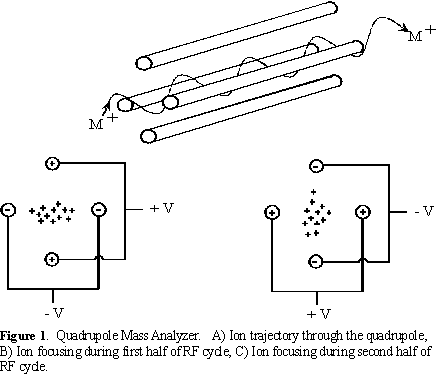
Quadrupole(1). The quadrupole mass spectrometer is the most common mass analyzer. Its compact size, fast scan rate, high transmission efficiency,(2) and modest vacuum requirements are ideal for small inexpensive instruments. Most quadrupole instruments are limited to unit m/z resolution(3) and have a mass range of m/z 1000. Many benchtop instruments have a mass range of m/z 500 but research instruments are available with mass range up to m/z 4000.

In the mass spectrometer, an electric field accelerates ions out of the source region and into the quadrupole analyzer. The analyzer consists of four rods or electrodes arranged across from each other (Figure 9). As the ions travel through the quadrupole they are filtered according to their m/z value so that only a single m/z value ion can strike the detector. The m/z value transmitted by the quadrupole is determined by the Radio Frequency (RF) and Direct Current (DC) voltages applied to the electrodes. These voltages produce an oscillating electric field that functions as a bandpass filter to transmit the selected m/z value.
The RF voltage rejects or transmits ions according to their m/z value by alternately focusing them in different planes (Figure 9). The four electrodes are connected in pairs and the RF potential is applied between these two pairs of electrodes. During the first part of the RF cycle the top and bottom rods are at a positive potential and the left and right rods are at a negative potential. This squeezes positive ions into the horizontal plane. During the second half of the RF cycle the polarity of the rods is reversed. This changes the electric field and focuses the ions in the vertical plane. The quadrupole field continues to alternate as the ions travel through the mass analyzer. This causes the ions to undergo a complex set of motions that produces a three-dimensional wave.
The quadrupole field transmits selected ions because the amplitude of this three-dimensional wave depends upon the m/z value of the ion, the potentials applied, and the RF frequency. By selecting an appropriate RF frequency and potential, the quadrupole acts like a high pass filter, transmitting high m/z ions and rejecting low m/z ions. The low m/z ions have a greater acceleration rate so the wave for these ions has a greater amplitude. If this amplitude is great enough the ions will collide with the electrodes and can not reach the detector. The low m/z value cutoff of the quadrupole is changed by adjusting the RF potential or the RF frequency. Any ions with a m/z greater than this cutoff are transmitted by the quadrupole.
A DC voltage is also applied across the rods of the analyzer. This potential combined with the RF potential acts like a low pass filter to reject high m/z ions. Because they respond quickly to the changing RF field the motion of the low m/z ions is dominated by the RF potential. This motion stabilizes their trajectory by refocusing each time the RF potential changes polarity. Because low m/z ions are quickly refocused, the DC potential does not affect these ions. High m/z ions, however, do not refocus as quickly during the RF cycle. The DC potential has a greater influence on their trajectory and they slowly drift away from the center of the quadrupole. At the end of the analyzer, they are too far off-axis to strike the detector.
The combination of high and low pass filters produced by the RF and DC potentials is adjusted to only transmit the selected m/z value. All ions above or below the set m/z value are rejected by the quadrupole filter. The RF and DC fields are scanned (either by potential or frequency) to collect a complete mass spectrum. Quadrupole mass analyzers are often called mass filters because of the similarity between m/z selection by a quadrupole and wavelength selection by an optical filter or frequency selection by an electronic filter.
1. Steel, C.; Henchman, M. J. Chem. Educ., 1998, 75, 1049-1054.
2. Transmission efficiency refers to how many of the ions produced in the source region actually reach the detector. This is an important measure of sensitivity for mass spectrometers.
3. Unit resolution (or low resolution) mass spectra distinguish between ions separated by 1 m/z unit. The spectra, like those presented here, are commonly displayed as histograms. This is a common method for presenting spectra because it results in much smaller data file size. Some mass analyzers can obtain spectra at much higher resolution. This is discussed in detail in the interpretation section.